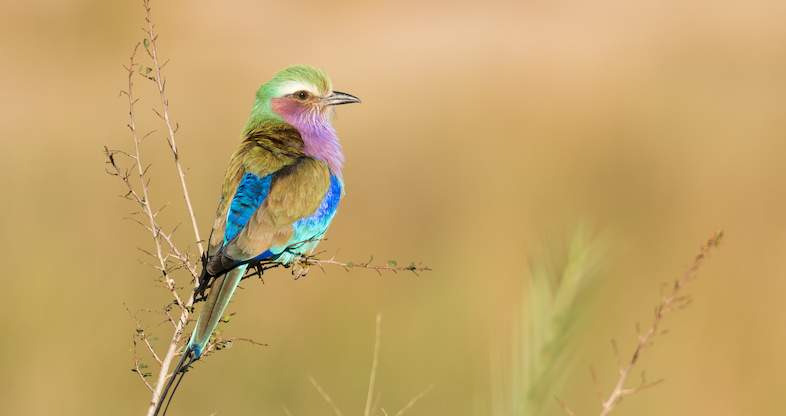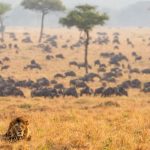Many tourists are persuaded to visit Kruger Park in South Africa’s Mpumalanga Province in order to see the ‘big five’ animals, prized and feared by game hunters during the 19th Century.
But while the ‘big five’ — lion, leopard, buffalo, elephant and rhinoceros — is indeed a prime attraction, it is not the only reason to visit Kruger Park.
Birdwatchers have identified the avian version of the ‘big five’, with one addition. The ‘big six’ of birds includes the kori bustard, the lappet-faced vulture, the martial eagle, the saddle-billed stork, the southern ground hornbill and Pel’s fishing-owl.
Kori Bustard (Ardeotis Kori)
With its dark crest and grey neck, this ground-dwelling bird can be seen striding through grassland and woodland, distinctively swinging its head backwards and forwards. Although it is largely confined to parks, the kori bustard is nonetheless widespread throughout South Africa, with the exception of the eastern and southern coastal districts. One of the best ways to see a Kori and the other big five birds is to go on a walking safari in the Kruger Park.
It has an unfortunate habit of flying into power pylons owing to the fact that it looks down rather than up when flying, which it only does reluctantly. While on the ground, the long-lived, slow-breeding bustard is an opportunistic omnivore, devouring anything from berries to lizards and snakes. The kori bustard is renowned for its elaborate courtship display.
Lappet-Faced Vulture (Torgos Tracheliotus)
At a kill, the lappet-faced vulture is likely to be the most recognisable of the avian scavengers. With its distinctive reddish-pink head and neck and large size (it is almost double the size of the hooded vulture), it will often try to dominate proceedings. This vulture, which is particularly partial to the central grasslands, is widespread in Kruger.
Rare outside major game reserves, the lappet-faced vulture delivers high-pitched whistles while displaying, but is otherwise rather quiet. It is a solitary bird that nests in treetops and is particularly vulnerable to accidental strychnine poisoning as it scavenges on the carcasses of animals, such as jackals, which have been poisoned by farmers.
Martial Eagle (Polemaetus Bellicosus)
The only eagle on the list also happens to be the largest in Africa; with its chocolate-brown head, black-spotted chest and slight, backward-facing crest, the martial eagle is unlikely to be mistaken for any other eagle, although from beneath it resembles the black-breasted snake eagle.
Widespread throughout South Africa, the martial eagle is nonetheless rare outside major game reserves. Given its impressive size, it is no surprise it takes on prey as large as 30 kilograms (66 pounds), including impala calves, monkeys, serval cats and jackals. It is also been known to attack European storks and snakes, and there have been reports that it’s even tried to make off with children in fields near rural villages.
Saddle-Billed Stork (Epphippiorhynchus Senegalensis)
There are a few fairly nondescript stork species that will require park visitors to reach for their bird guides in order to identify them, but the saddle-billed stork isn’t one of them. With its striking red and black bill, punctuated by a yellow ‘saddle’ at the base, this bird is instantly recognisable.
Found throughout the park alone or in pairs, the stork frequents rivers or waterholes near riverine forests, and is largely silent except for the bill-clattering it makes during displays. It eats crabs, fish, frogs and small birds as well as reptiles, and is represented in a hieroglyph from Ancient Egypt.
Southern Ground Hornbill (Bucorvus Leadbeater)
Few sounds in the African bush are as evocative as the dawn call of the southern ground hornbill — a booming ‘oomph, oomph-oomph’. The bird itself, the largest of the hornbill species, is as impressive as its call — a black turkey-sized specimen (which is often confused for a turkey buzzard) with a scarlet face and throat, and a heavy, decurved bill.
Largely terrestrial, ground hornbills walk slowly through the bush in small family flocks, searching for food such as reptiles, amphibians, molluscs, insects and small mammals. With its long eyelashes and slow, deliberate movements, this bird has an almost aristocratic demeanour but look less at ease when in flight.
Pel’s Fishing-Owl (Scotopelia Peli)
If there is one member of the ‘big six’ you are unlikely to see, it is Pel’s fishing-owl. This elusive raptor is nocturnal and restricts itself to large bodies of water. In fact, a perusal of the owl’s distribution shows that it is largely absent from South Africa, preferring Mozambique.
However, it does occur in the Kruger Park, and surveys indicate it is most likely to be seen in the Pafuri district, at the park’s northern extreme. Pel’s fishing-owl is recognisable owing to its size and reddish-brown colouration, and is named for Hendrik Severinus Pel, the Dutch governor of the Gold Coast (now Ghana) in the 1840s.








